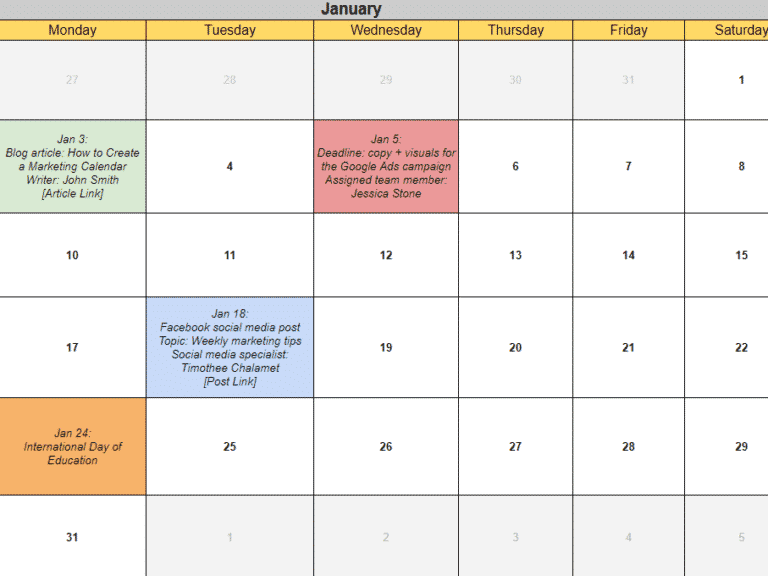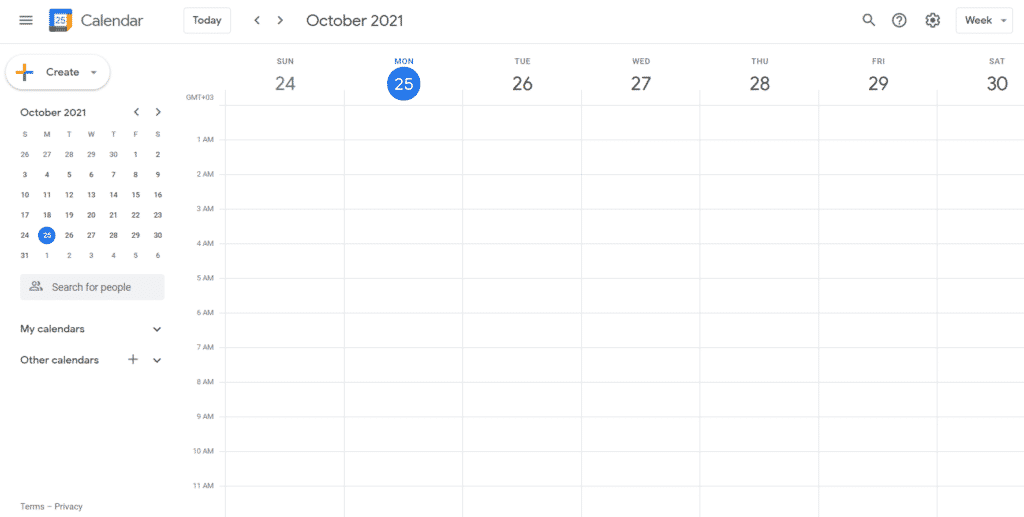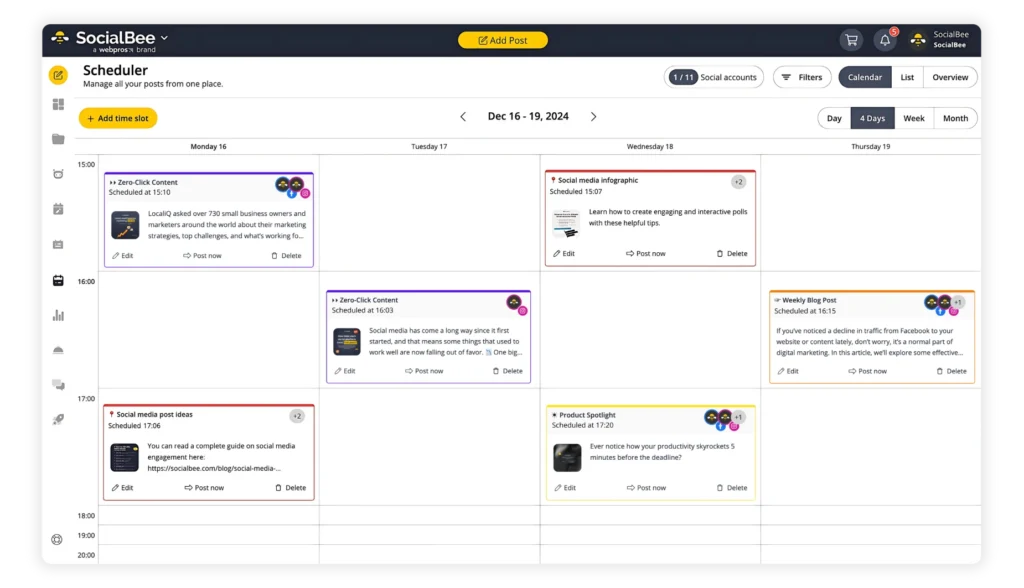Daily tasks, projects, deadlines, business meetings… What do they all have in common? They are taking up time from your marketing calendar.
With so many things going on at the same time, it’s easy to lose sight of the big picture.
The chaos of the everyday marketing agenda gets amplified by a lack of planning. Luckily, there are ways to cope with such challenges, such as developing a social media marketing plan and creating a marketing calendar.
However, in today’s article, we are going to focus on the marketing calendar concept.
You will not only learn how to create a marketing calendar, but you will also receive a free template that gives your marketing strategy a clear structure.
But enough with the introduction, let’s get into today’s topic.

What Is a Marketing Calendar?
Before you start using our marketing calendar template, you need to understand the process behind it.
So, let’s start by answering the following question: What is a marketing calendar?
A marketing calendar is a document that organizes all the future activities your marketing team plans to do in a specific time frame. It provides an overview of the marketing strategy, including details such as the responsibilities of each team member and the progress made with each passing day. Most of the companies choose to go with an annual calendar, but it can also be done on a quarterly basis.
Furthermore, marketing calendars can be made in an electronic or print format. However, we advise you to go for an electronic calendar, as it’s easier to access and update by your whole team, even remotely.
A marketing calendar is a document that provides directions for everyone involved in the marketing strategy. Moreover, it gives you time to think and premeditate all the promotional activities, so you can boost your marketing results.
With everything planned months ahead, all you have to do is focus on all your marketing activities and make the most out of them. You and your team will not have to think about what you should do next, because everything is already settled and documented in the marketing plan calendar.
Marketing calendars contain the following information:
- Upcoming marketing projects; from social media campaigns to product launches and events.
- Specific roles and responsibilities for each team member.
- Specific dates and deadlines for all the planned marketing activities.
The Benefits of a Marketing Calendar
Such a calendar makes you think about your marketing strategy from a different perspective because it allows you to consider all the opportunities you have throughout the year to promote your products and services.
You can identify holidays, company anniversaries, and even organize events to celebrate these occasions. Also, marketing calendars help you prepare for busy times of the year with special sales or promotions.
So, what makes a marketing calendar important? If you are still not sold on the idea of using an annual marketing calendar template, here are more benefits that it could bring to your marketing team:
- It provides accountability – A calendar helps you assign clear roles within your team, while also enabling you to oversee if their tasks are finished on time.
- It helps you measure your results – When the results of a marketing calendar are evaluated after a project is finished, its usefulness is heightened. This enables team members to uncover gaps that weren’t expected and learn from the outcomes of every endeavor. A marketing calendar’s historical usefulness might offer helpful insights into any future efforts by evaluating statistics, calculating whether targets were accomplished and how soon they were attained.
- It helps you achieve business goals – By following through with your marketing plans, you are able to come closer to achieving your goals. After all, every project from your calendar is tied to a business goal or a desired result. Besides, a marketing calendar constantly reminds you to focus on your strategy and to plan ahead.
- It allows you to stay on budget – Planning all your projects ahead of time will help you allocate your resources wisely, without going over your budget. You can also integrate a budget tracker in the calendar for the best results.
- It offers clear directions – A well-written calendar will provide clear directions for all the team members about: upcoming projects, responsibilities, posting frequency, deadlines. An overview of who should be working on what and when is provided to team managers and members. As a result, it is simpler to see gaps in work and adjust schedules as needed. Your team members will be organized and ready for action because they have all the necessary details to start working.
- It helps you save time – Marketing teams may better communicate and spend less time aligning the team because task information is organized and available to everyone. Even while certain plans call for flexibility, following and communicating a predetermined framework is simpler than doing so on the spot. Team members have something to rely on in a hectic work atmosphere when things get chaotic.
Top 8 Must-Haves for Your Marketing Calendar
If setting up a marketing calendar sounds like a good idea for you, we made the creation process a little easier by breaking it down.
These are the 8 top must-haves for creating a marketing calendar:
- A marketing calendar tool
- A great understanding of your target audience
- Relevant dates and events
- Established roles for each team member
- Details about marketing campaigns
- A blog content schedule
- A social media strategy
- An ad plan
Keep reading to learn what you need in order to create an effective calendar for your marketing strategy.
1. A Marketing Calendar Tool
Before you create your calendar, you have to choose a tool that will allow you to organize all your projects and activities.
There are no rules in choosing a calendar format, whatever works best for your team is the best choice. You can go for a printed simple marketing calendar template or an electronic one made in spreadsheets or Google Calendar.
The foundation of a brand’s marketing plan will be this shared calendar. In order to more accurately predict new strategies, it will also act as a historical point of reference for earlier marketing initiatives. In order to better enhance their marketing methods, the team can use it to track any successful and unsuccessful strategies.
Make sure to consult with your team before you decide. After all, they will work the most with the calendar.
2. A Great Understanding of Your Target Audience
At the center of any marketing initiative stands the customer. And for a good reason.
So, before you learn how to create a marketing calendar, you first need to get to know your clients.
Ultimately, what any business wants to achieve is to get their target audience to find out about their products and services, convince them to make a purchase, and maintain them as regular customers.
While planning your marketing projects for an extended period of time, you must find ways to reach your target audience. This can be done through multiple methods such as developing a social media content strategy, running ads, organizing different promotions, and more.
If you get this first step right, you will set yourself up for success. It’s very important to consider your target audience first because it allows you to get both the timing and the marketing message right.
For example, if you own a flower shop, you will identify holidays like Valentine’s Day, Women’s Day, Mother’s Day in your calendar and create social media and ad campaigns to target a specific audience, in this case, mostly men.
Here are some questions you need to answer about your target audience before creating your content marketing calendar:
- What are their main needs and desires?
- What are they passionate about?
- Where can I find them online and offline?
- What are their challenges and pain points?
3. Relevant Dates and Events
A marketing calendar is a great tool that helps you make the most out of key moments throughout the year.
So, to plan events, promotions, and content for these opportunities, you first must identify important dates and write them down on your calendar. Similarly, you can look online for important holidays and international celebration days.
You don’t want to forget about the events such as April Fool’s Day or the International Women’s Day, as they are key dates to generate simple, yet effective, content ideas.
You should also go through your analytics from past years to discover the most profitable and unprofitable time frames, so you can plan marketing initiatives to boost your sales.
4. Established Roles for Each Team Member
Marketing departments are, most of the time, more than a one-man show.
If you want to utilize your calendar to organize your entire team, you need to assign roles within the document. As a result, your team will be able to prepare for the following projects ahead of time while also managing their tasks more effectively.
Besides, this way, you will not have to keep assigning roles for each upcoming activity. Therefore, for each section of your calendar, you should have a column dedicated to the team members responsible for the task. You can have someone in charge of the content calendar, and another team member in charge of the email marketing strategy.
Having set a marketing calendar makes it easier for your team to manage their workflow. With the use of personal task lists and notifications, deadlines may be managed way easier. Project management marketing calendars with automation features can alert coworkers when it’s their turn when a team member is waiting for a task to be finished before they can get started.
5. Details about Marketing Campaigns
Your yearly marketing plan should be divided into several marketing campaigns, each with its own marketing goals.
Maybe during a specific month, you want to promote a certain line of products and services and sell more of them as a result. Similarly, other marketing campaigns could focus on increasing brand awareness, launching a new product or service, or even rebranding your business.
It all depends on what you want to achieve through your marketing efforts. Knowing what your business objectives are will allow you to create marketing campaigns that will provide desired results.
In the marketing campaign calendar template, you should include:
- The name of the marketing campaign
- The campaign type
- The time frame in which it will take place
- The marketing goals of each campaign
- The main communication platforms
- The activities and people involved in the process
6. A Blog Content Schedule
Having a blog will also require a content marketing strategy, time, and personnel. So, considering the necessary resources, it’s a good idea to include your blog in your marketing calendar.
In the content planning, you should include: the article titles, the date they should be posted on your blog, the article link, and the name of the assigned content writers.
And if you hire a ghostwriter or work with freelancers, make sure to formalize this information in a brief to help your writers optimize their content.
You can also go a step further and create a content marketing calendar template, especially for your blog posts. This will help you keep your blog content separate and easy to follow.
Keep in mind that including all the details of your marketing plan in the calendar will end up looking chaotic and unorganized — the opposite of what you want to achieve.
7. A Social Media Strategy
Social media content creation is a big part of a marketing strategy. It involves several communication channels, each with its own set of guidelines.
Also, maintaining an effective social media presence requires creating quality content, keeping a constant posting schedule, and interacting with online audiences.
That’s why most marketing calendar templates include a social media component. Yet, since this is a marketing calendar and not a social media calendar, you should add the following information:
- The social media platform
- The topic of the social media posts
- The link to the social media content
- The names of the social media specialists
Although these details are great to include in a marketing calendar, you should also craft a social media plan if you want to develop a comprehensive online strategy.
Besides the information presented above, a social media calendar also contains details about future post topics or ideas, the copy text, visuals, and more.
Create, schedule, and post all your social media content from SocialBee.
Start your 14-day free trial today!
Once you have your content figured out, you can use a social media management tool like SocialBee to streamline your posting system.
Save time and effort by creating, editing, and posting content directly to your social media accounts from one dashboard. In fact, the dashboard itself is organized as a social media marketing calendar template.

8. An Ad Plan
Depending on your marketing budget and on the products and services that you want to promote, you can create ad campaigns to boost your business profit. Advertising is an essential part of a marketing strategy, so you should definitely include your ad campaigns in your marketing calendar.
Before doing this, however, you should think about what you want to achieve through advertising and the best time to run the ads.
For example, if you sell school supplies, the best time to run ads would be a couple of weeks before the school year starts.
Here are the details and key metrics you should add to the digital marketing calendar:
- The deadline for the ad content
- The ad campaign objectives
- The team members involved in the campaign
- The duration of each marketing campaign
- The advertising channels (TV, print, social media, Google)
Should I Create Multiple Calendars?
When you want to plan your marketing activities, it is essential to include the main activities or each of your sub-departments. This way, you will be able to keep track of what is being done, and you can start planning ahead in case any marketing stream is not being utilized enough.
Separately, each team lead can create sub-calendars with more detailed information for marketing each activity they are pursuing: social media marketing, email marketing, content marketing, and so on. It might be useful to link all these smaller calendars to the main marketing one, so each team member can see (on the same page) what everyone else is working on.
Start Planning Your Marketing Calendar!
Now that you know what a marketing calendar is and why it’s a valuable addition to your workflow, you have to make a decision.
Are you ready to include a marketing calendar in your strategy?
If you said yes, then in today’s article, you will find all the information you need.
And to add the cherry on top of the marketing cake, here is the marketing calendar template. All you have to do is make a copy of our marketing calendar template and edit it based on your needs to make it your own.
So, what are you waiting for? Start creating a complete marketing calendar that will not only help you make the most out of all your marketing efforts, but will also improve the way your team collaborates.












